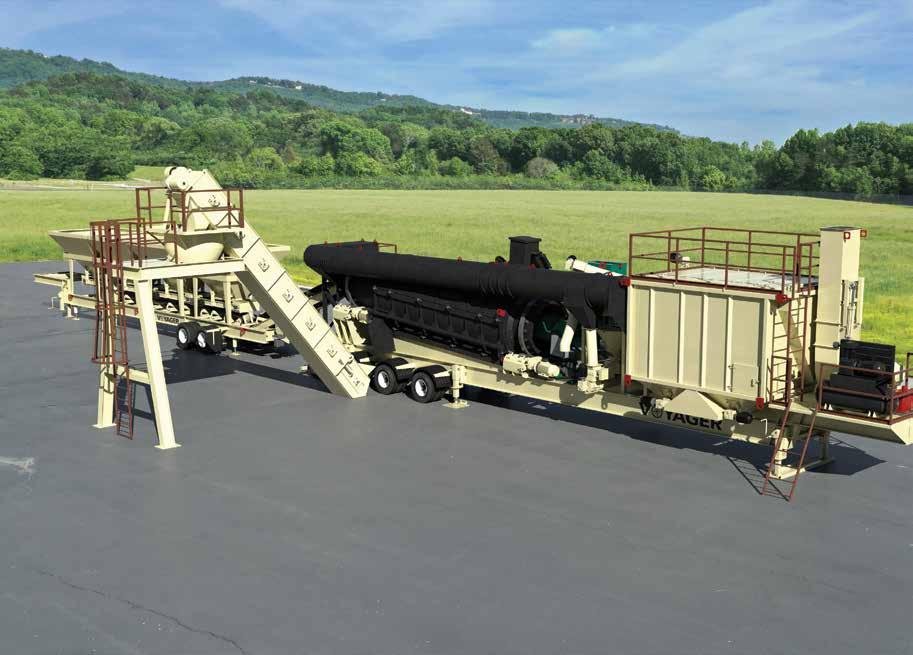
4 minute read
Train Your Crew to
Train Your Crew to Prevent Strains & Sprains
AAsphaltPro has covered serious on-the-job hazards like struck-bys and caught-in/between threats time and again, it’s also important to be aware of injuries resulting from the physical work done each day that adds up over time.
For example, when AsphaltPro requested top tips for new crew members from our seasoned social media followers, we found “proper shovel technique” was the advice we received most often. It’s one of those actions that may not hurt the first hundred times you do it wrong, but its impact adds up over time.
According to the Center for Construction Research (CPWR), one in five construction workers experiences musculoskeletal disorders, including sprains, strains and soft tissue injuries, which gradually worsen and are often chronic. That’s why, earlier this year, CPWR released a new ergonomics training program for construction workers.
CPWR’s Best Built Plans’ Comprehensive Ergonomics Training Program was developed to reduce risks associated with manually lifting and moving materials.
Early symptoms can be treated with rest, ice, compression and elevation (RICE). It’s important not to ignore early symptoms, because as the symptoms become moderate to severe, the body may not be able to recover completely even with extensive rest and surgery may be required.
CPWR also reminds us of the risks of opioid dependence. “Only use opioids if they are prescribed by a doctor and determined to be the best option to manage the pain,” the program warns. “It’s important to remember that opioids are strong, addictive medications.”
According to CPWR, ergonomics aim to prevent injuries by “setting up the work environment and tools to make the job fit the physical abilities of the worker.”
The program outlines six ergonomic hazards: • High force (physical effort needed to move a load) • Poor postures (position of the body that is not in alignment) • Fast or prolonged repetition (repeatedly moving a body part to perform a task) • Stress from body contact (when your body comes in contact with an object) • Hand or body vibration (common when using a power tool, but also body vibrations caused by operating powered equipment while sitting) • Cold environments (causing muscles to tighten and feel stiff)
Although each of these hazards is present in construction, high force and poor postures are often the most common.
NIOSH’s lifting equation can help determine a safe weight for each employee—and it will vary from person to person.
“Everyone’s body has different abilities: strength, flexibility, and tolerance,” states the program. “By working within the physical limits of your body, you eliminate the risk of soft tissue injuries and overexertion, sprain, and strain injuries.”
If it’s not possible to use the equation, a safe rule of thumb is that one person should not lift objects weighing more than 50 pounds on their own and should not carry heavy objects long distances of more than 100 feet, and that the route is free of obstacles, slip and trip hazards. Additionally, anything weighing more than 25 pounds should be handled at waist height.
The program outlines a number of safe lifting practices.
The second common ergonomic hazard in construction is awkward postures, and includes working on the ground or reaching overhead. For the asphalt crew, you may need to spend some time on the ground, using the straight edge or density gauge. Be sure to CONTROLS limit your time on the ground and use knee pads or other cushioning if you need to be kneeling.
Otherwise, to the best of your ability, your work should be around waist height and the work should be located close to your body. It’s okay if you occasionally need to reach as far as your fingertips, but you should not need to reach beyond your fingertips as this can lead to injury over time. CONTROLS
The program also illustrates the hierarchy of ergonomic controls, rating engineering-based controls as the best, followed by work practices, then administrative, and lastly, “other” controls which includes personal protective equipment (PPE).
Engineering controls often use equipment to reduce risk. Work practices include positioning the material better or using proper lifting technique. Administrative controls include assigning more CONTROLS workers to or rotating workers through an ergonomically challenging task. PPE controls include knee pads for kneeling work or stretching before and after.
“Stretching exercises can also help and are recommended to improve flexibility, movement, and posture, and relieve muscle and joint tightness,” suggests the program. For more information on proper stretching, visit theasphaltpro.com to read our arCONTROLS ticle “Prevent Injury on the Paving Job with these Construction Stretches.”
CPWR’s program also has a number of interactive training and coaching resources. CPWR also points out two free smartphone games to help train workers in proper lifting techniques, Lift Coach: Plan Your Route and Lift Coach: Plan Your Lift. There is a free app version of Best Build Plans available for iOS and Android. CONTROLS Best Built Plans also has planning tools and other resources, such as Toolbox Talks, videos, guides, checklists and handouts. For more information, visit CPWR’s ergonomics training program page on www.cpwr.com.
– BY ASPHALTPRO STAFF
ULTRA-PORTABLE ASPHALT PLANTS
PARTS
ULTRA-PORTABLE ASPHALT PLANTS PARTS
AND WE DO THIS... ULTRA-PORTABLE ASPHALT PLANTS PARTS
VOYAGER DOUBLE BARREL TM ASPHALT MIXING PLANT
Small plant footprint, big plant features. ULTRA-PORTABLE ASPHALT PLANTS PARTS
The Astec Voyager DB plants delivers full-size plant features in a compact, highly-portable configuration. Based upon
Astec’s proven Double Barrel ® drum mixer, with production capacity up to 140 tonnes/hr and RAP mixing capability up to 50%, the Voyager DB plants sets the standard for portability, production, and sustainability. ULTRA-PORTABLE ASPHALT PLANTS PARTS
SALES: 423.867.4210
A unique approach to asphalt mixing technology.
MOBILITY
The modular design enhances portability and reduces setup time
EASY PLANT ERECTION
No cranes needed for set-up
RECYCLE
Can produce asphalt pavement mix with up to 50% recycle content
FLEXIBILITY
Easily adapts to the local site










